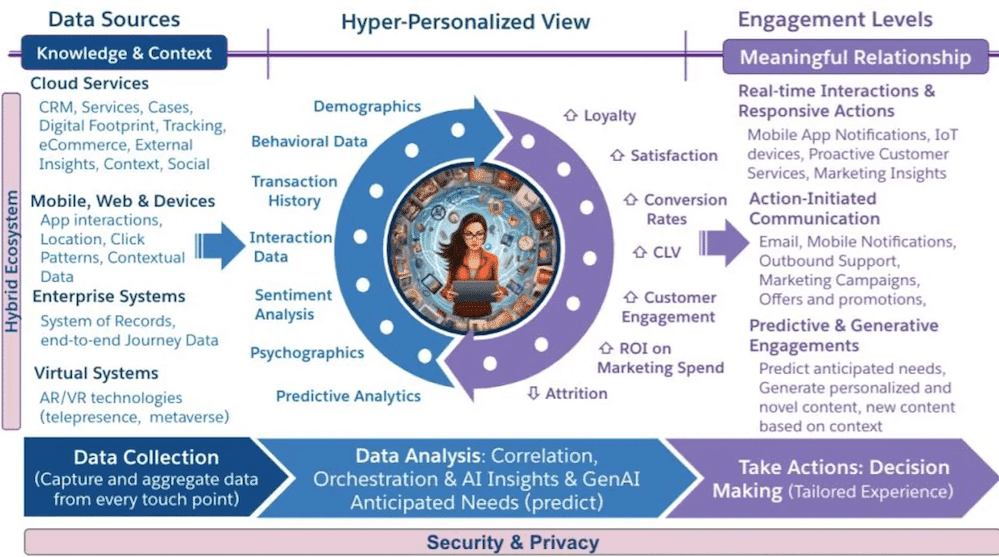In a world driven by constant connectivity, online experiences need to be more personalised than ever before. This hyper-personalised approach aims to create the most relevant and customised experience for each user. But what does the term “hyper” in hyper-personalisation mean, and why is it such a crucial part of today’s digital marketing strategies?
A new level of hyper-personalisation using AI machine learning
The “hyper” in hyper-personalisation signifies a level of personalisation that extends beyond traditional personalised experiences. If it uses segmentation it is not unique and individualised to a specific person. Instead of using basic information like a user’s name or location to personalise experiences, hyper-personalisation — also known as extreme personalisation or individualisation — leverages advanced technology and data analysis techniques.
This approach provides a deep understanding of user behaviour, preferences, and needs, resulting in tailor-made experiences that drive user engagement and loyalty — it utilises behavioural and real-time data to create highly contextual interaction that is relevant to the user at the right moment of their journey.
Data: The fuel of hyper-personalisation using AI machine learning
To achieve this level of personalisation, brands employ data analytics, artificial intelligence (AI), and machine learning (ML). These technologies allow businesses to gather, analyse, and apply vast amounts of data from various sources like browsing history, past purchases, and social media activity.
Using this data, brands can anticipate a user’s needs, preferences, and potential future actions with high accuracy. This could mean recommending a product the customer might like, informing them about an event they might be interested in, or even offering personalised discounts that motivate a purchase.
AI algorithms can readjust behavioural data incrementally based on each new interaction, making marketing campaigns progressively smarter as they roll out across more customers and channels. The use of AI in hyper-personalisation lets you create and adjust customer profiles in real time. It goes further than segmentation and allows you to create a customer experience that is unique to an individual. The distinction in returns can be as much as 20:1 according the the likes of McKinsey, Forrester and BCG.
Hyper-personalisation: Benefits and challenges
Businesses that can deliver hyper-personalised experiences position themselves as attentive and responsive, which fosters trust among consumers. Here are a few important benefits of hyper-personalisation:
- Improved customer experience: By tailoring content, recommendations, and interactions to individual preferences and behaviour, businesses can create a unique, satisfying user experience. This can increase customer engagement, loyalty, and overall satisfaction.
- Increased conversion rates: Hyper-personalisation can lead to more effective marketing campaigns and ecommerce strategies. By showing customers the right message at the right time, conversion rates can significantly improve.
- Enhanced customer loyalty: By continuously delivering personalised experiences, businesses can foster a strong relationship with their customers. This can increase customer retention and loyalty, resulting in more repeat purchases and a higher customer lifetime value.
- Competitive differentiation: In an increasingly crowded marketplace, hyper-personalisation can provide a way for businesses to stand out. It can act as a key differentiator, making a brand more appealing to customers.
The challenges of hyper-personalisation using AI machine learning
Striking the right balance between personalisation and privacy is crucial. Organisations must ensure they comply with data protection regulations and must handle their customers’ data responsibly.
- Data privacy and security: While hyper-personalisation requires extensive data collection, businesses must handle this data responsibly. They must adhere to privacy laws and regulations, such as the Data Protection Act in the UK, GDPR in Europe or CCPA in California. Failure to do so can result in severe penalties.
- Balancing personalisation and intrusiveness: Striking the right balance between personalisation and being intrusive is another challenge. Too much personalisation can make customers feel their privacy is being violated, which can harm the relationship. Done perfectly sees them enjoy being presented with the perfect array of products pertinent to their exact preferences at the perfect time, every time.
- The complexity of implementation: Implementing a successful hyper-personalisation strategy can be complex and time-consuming. It requires the right technology, integrated business processes, a thorough understanding of the customer, and ongoing efforts to maintain and optimise the new personalisation strategy.
Technology challenges with hyper-personalisation
Implementing hyper-personalisation at scale often poses several technical challenges for enterprises:
- Data integration: Organisations often collect data from multiple sources, which can lead to fragmented and siloed data. Integrating this data into a single, unified view of the customer is a major challenge.
- Data analysis capabilities: Many organisations lack the advanced analytical capabilities required to gain meaningful insights from the vast amounts of data they collect. Without these insights, effective personalisation is not possible. Early adoption of technology may be the solution to this.
- Real-time processing: Hyper-personalisation often requires real-time decision-making. This means organisations need the infrastructure to process and analyse data in real time, which can be technically challenging and resource-intensive. Note that analysis alone is merely that, whereas AI enables this on a perpetual, live-streaming basis with the right technology. Better still, one that both enables practical use of that data at the ideal pinnacle.
- Scalability: As the volume of data increases, so does the demand for systems to analyse and respond to this data. Businesses need scalable systems to handle this load and to grow with their personalisation efforts. You need to manage your AI risks.
- AI/ML expertise: The use of AI in general and ML for data analysis and prediction is a crucial part of hyper-personalisation. However, implementing these technologies requires specialised expertise that many organisations do not have in-house.
Hyper-personalisation presents a significant opportunity for businesses to create unique, compelling experiences for their customers. However, it also comes with its share of challenges in terms of strategy and technology. With careful planning and the right approach, these challenges can be overcome, and the benefits of hyper-personalisation can be fully realised. There are conflicting visions.
Essential components for achieving hyper-personalisation
- Data collection: This is the first step, and perhaps the most crucial. You need to collect detailed data about your customers. This is no longer demographic data but is transaction history, browsing behaviour, length of time viewing a product, repeat product viewing data, social media activity, purchase history, browsing history, search history, social media activity, cognitive dissonance analysis, and other online interactions. This data is then analysed using machine learning algorithms to create personalised experiences for each consumer.
- Data analysis: Once you’ve collected the data, it needs to be analysed to extract meaningful insights. This could involve identifying trends, preferences, and behaviour that can help predict future actions.
- Artificial intelligence, machine learning, and generative AI: AI, and ML are the engines that drive hyper-personalisation. These technologies can analyse large amounts of data, learn from it, and make predictions or decisions without being explicitly programmed to perform the task. Generative AI takes personalisation beyond reactive adjustments and actions, enabling businesses to predict and generate content tailored to anticipate future customer behaviour and preferences. This includes creating custom promotional offers, hyper-personalised product-selected emails, or unique user experiences. By doing so, generative AI adds another layer of proactiveness to personalisation, significantly enhancing customer engagement and taking the personalisation aspect to new heights by adding a Generative Experience.
- Real-time decision making: Hyper-personalisation requires making real-time decisions based on the collected data and insights. This could be as simple as serving up a personalised product recommendation or as complex as dynamically tailoring the entire user experience.
- Customer journey mapping: Understanding and monetising the customer journey is essential to provide individualised personalised experiences at every touchpoint. This involves identifying the different stages customers go through when interacting with your brand, from the awareness stage to the purchase stage, and beyond.
- Security and privacy: As you’ll be dealing with large amounts of personal data, it’s crucial to ensure that you’re handling this data responsibly and complying with all relevant privacy laws and regulations.
- Testing and optimisation: Finally, continuous testing and optimisation are important. This involves regularly testing your personalisation efforts to see what works and what doesn’t, and making necessary adjustments to improve the customer experience. Adoption of already advanced technology is readily available through adoption via plugins from companies that do nothing else than enhance and deliver the greatest possible returns for you already.

The goal of hyper-personalisation isn’t to simply collect and use as much data as possible. It’s to use that data to provide a truly personalised experience that meets each customer’s needs and preferences.
Creating a 360-degree customer view via hyper-personalisation involves obtaining a comprehensive understanding of the customer at multiple levels. Here are some key attributes to consider:
- Demographics: Basic information like age, gender, location, income, occupation, etc. This gives a baseline understanding of who your customer is.
- Psychographics: Information about a customer’s lifestyle, preferences, interests, values, and personality traits. This helps businesses tailor their messaging and offerings to align with the customer’s lifestyle and values.
- Behavioural Data: This includes data related to customers’ online behaviour such as browsing history, click patterns, frequency of visits, time spent on specific product pages, items added to cart, abandoned carts, purchases, product reviews, etc. This data is crucial for understanding customer behaviour and predicting future actions.
- Transaction history: Purchase history, frequency of purchases, average spend, types of products or services purchased, etc. This information can help businesses identify buying patterns and anticipate future needs.
- Interaction data: This includes data from every touchpoint a customer has with a brand, such as customer service interactions, social media engagement, email exchanges, etc. It provides insight into how the customer interacts with the brand across different channels.
- Sentiment analysis: Analysis of customer reviews, social media posts, or any other customer feedback can provide insights into how a customer feels about a brand or a product. This can help businesses improve their products or services and manage their reputation effectively.
- Predictive analytics: Based on all the above data, businesses can use predictive analytics to anticipate future behaviour or needs of a customer. This is a key component of hyper-personalisation as it allows businesses to proactively cater to their customers’ needs.
When the attributes of a 360-degree customer view are well-managed and utilised effectively, the results can be transformative for both businesses and their customers. Here are some outcome attributes you can expect:
- Customer loyalty: Hyper-personalised experiences, products, and services make customers feel valued and understood, which in turn, fosters loyalty and encourages repeat business.
- Improved customer satisfaction: By accurately predicting and meeting customer needs, businesses can significantly enhance customer satisfaction levels. Satisfied customers are likely to remain loyal and spread positive word-of-mouth, amplifying your brand’s reputation.
- Increased conversion rates: Hyper-personalisation can boost conversion rates by providing customers with relevant, timely, and individually personalised offers, recommendations, and content that encourage purchase decisions.
- Enhanced customer engagement: By creating personalised experiences, businesses can increase customer engagement levels, leading to longer session times, increased click-through rates, and overall, a more involved customer.
- Higher customer lifetime value (CLV): With increased loyalty, satisfaction, and engagement, comes a higher CLV. Hyper-personalised experiences often lead to increased purchase frequency and spending, resulting in a higher overall value for each customer over their lifespan.
- Greater ROI on marketing spend: Hyper-personalised marketing efforts typically yield a higher return on investment. By targeting the right person with the right message at the right time, businesses can optimise their marketing spend and improve campaign effectiveness. Effective on-page CRO and hyper-personalisation still need the consumers to visit your site to be effective, no visit no use, whereas emails adopting the same technology can reach them wherever they are at the perfect time.
- Attrition reduction: Hyper-personalisation can help reduce customer attrition by making customers feel understood and valued, which discourages them from switching to competitors. This practice is critical for maintaining a stable customer base and is typically more cost-effective than acquiring new customers. By proactively understanding and meeting customer needs, businesses can prevent issues that may cause customers to leave, thereby reducing attrition. Overall, hyper-personalisation fosters strong customer relationships, enhancing loyalty and minimising churn rates.
The journey to effective hyper-personalisation is a continuous process. It requires ongoing data collection, analysis, and optimisation to ensure that personalised experiences remain relevant and valuable to the customer. The key is to keep the customer at the centre of all efforts, using insights derived from data to drive decision-making and strategy.
Hyper-personalisation in the context of a customer-centric view requires businesses to respond in real time and also be proactive. This dual strategy enhances customer loyalty and engagement.
The first mechanism, “Real-time interactions and responsive actions,” (Forbes) responds to live data, for instance, notifying a customer about a price drop for a product they’re interested in. The key to this strategy is timing, relevance, and avoiding overly intrusive interactions.
The second mechanism, “Action-initiated communication,” triggers communication, based on specific customer behaviour, such as sending a personalised email for an abandoned shopping cart or re-engaging an inactive customer with a special deal. the distinction is in the ROI.
Finally, the third mechanism, “Predictive and generative engagements,” leverages generative AI to anticipate future customer behaviour and create content accordingly. It can generate highly personalised content that caters to a customer’s future needs, such as a personalised shopping guide or a promotion highlighting a brand’s sustainability efforts, for a customer who frequently shops for sustainable products. These mechanisms, together, provide a highly personalised customer experience, augmenting customer engagement and boosting conversion rates.
The future of hyper-personalisation using AI machine learning
As we move forward, the demand for more personalised experiences is likely to increase. Technology will continue to evolve, providing marketers and solutions in general with even more tools and capabilities to achieve hyper-personalisation. Businesses that can effectively harness the power of hyper-personalisation, while respecting privacy concerns, are likely to have a competitive edge.
Hyper-personalisation represents a new era in customer engagement. It’s about understanding consumers on a deep level and delivering value to each individual. The “hyper” in hyper-personalisation truly reflects this intensified, focused approach to individual customer experiences. By leveraging technology and data, brands can create a hyper-personalised experience that makes every customer feel like the only customer.
Click here to choose a hyper-personalisation SaaS for your ecommerce platform today.





